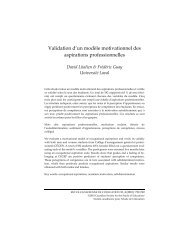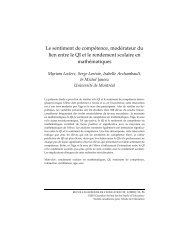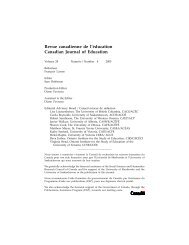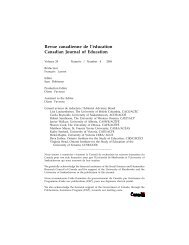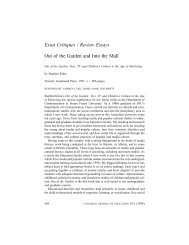Mireille Falardeau et Michel Loranger Le choix de stratégies ... - CSSE
Mireille Falardeau et Michel Loranger Le choix de stratégies ... - CSSE
Mireille Falardeau et Michel Loranger Le choix de stratégies ... - CSSE
Create successful ePaper yourself
Turn your PDF publications into a flip-book with our unique Google optimized e-Paper software.
ACTIVITÉS D’APPRENTISSAGE EN FORMATION À DISTANCE 345<br />
nant s’aperçoit qu’il ne comprend pas bien ce qu’il lit <strong>et</strong> déci<strong>de</strong> <strong>de</strong> reprendre sa lecture, il réalise<br />
une activité <strong>de</strong> type métacognitif qui lui perm<strong>et</strong> <strong>de</strong> contrôler son activité cognitive <strong>de</strong> lecture <strong>et</strong>,<br />
en principe, d’améliorer sa compréhension. <strong>Le</strong> fait <strong>de</strong> relire, cependant, est une activité <strong>de</strong> type<br />
cognitif qui lui perm<strong>et</strong> d’atteindre le but fixé.<br />
3<br />
La littérature inclut dans l’“affectif” tous ces aspects. <strong>Le</strong>bel (1989) <strong>et</strong> McCombs <strong>et</strong> Marzano<br />
(1990) distinguent la motivation <strong>de</strong>s autres aspects que l’on peut classer sous le terme “affectif.”<br />
4<br />
<strong>Le</strong> schéma est “une structure globale plus ou moins abstraite ou générale (. . .) qui représente <strong>de</strong>s<br />
regroupements <strong>de</strong> connaissances rendant compte d’obj<strong>et</strong>s, <strong>de</strong> situations ou d’événements dans ce<br />
qu’ils ont <strong>de</strong> typiques” (Deschênes, 1988a, 40–41).<br />
5<br />
<strong>Le</strong> compagnonnage correspond à une situation d’apprentissage où l’ouvrier apprend en situation<br />
réelle avec un maître <strong>et</strong> en collaboration avec les autres compagnons.<br />
6<br />
<strong>Le</strong>s macro<strong>stratégies</strong> visent l’organisation <strong>de</strong>s connaissances; elle perm<strong>et</strong>tent “d’organiser une série<br />
d’habil<strong>et</strong>és <strong>et</strong> <strong>de</strong> connaissances reliées entre elles dans un cours. Ainsi, une macro<strong>stratégies</strong> est<br />
utilisée pour structurer un certain nombre d’idées différentes dans un cours” (Van Patten <strong>et</strong> al.,<br />
1986, p. 438). Une microstratégie porte sur une idée, un concept, un principe ou une procédure.<br />
C<strong>et</strong>te distinction, faite par ces auteurs, renvoie donc à <strong>de</strong>s intervention favorisant un traitement<br />
global (macro) ou local (micro) <strong>de</strong>s informations.<br />
RÉFÉRENCES<br />
Alexan<strong>de</strong>r, P. A., Schallert, D. L. <strong>et</strong> Hare, V. C. (1991). Coming to terms: How researchers in learning<br />
and literacy talk about knowledge. Review of Educational Research, 61, 315–343.<br />
Andre, T. (1990). Type of inserted question and study-posttest <strong>de</strong>lay. Journal of Experimental<br />
Education, 58(2), 77–86.<br />
Anstey, M. (1988). Helping children learn how to learn. Australian Journal of Reading, 11(4),<br />
269–277.<br />
Armbruster, B. B. (1984). The problem of “inconsi<strong>de</strong>rate text.” In G. G. Duffy, L. R. Roehler <strong>et</strong> J.<br />
Mason (Eds.), Comprehension instruction, perspectives and suggestions (pp. 202–217). New<br />
York: Longman.<br />
Ballstaedt, S.-P. <strong>et</strong> Mandl, H. (1985). Diagnosis of knowledge structures in text learning (Forschungsberichte<br />
no. 37). Tübingen: Deutsches institut für Fernstudien an <strong>de</strong>r Universitat Tübingen.<br />
Baud<strong>et</strong>, S. <strong>et</strong> Denhière, G. (1989). <strong>Le</strong> fonctionnement cognitif dans la compréhension <strong>de</strong> teste. Questions<br />
<strong>de</strong> logopédie, 21(2), 15–30.<br />
Beck, I. L., McKeown, M. G., Sinatra, G. M. <strong>et</strong> Loxterman, J. A. (1991). Revising social studies text<br />
from a text-processing perspective: Evi<strong>de</strong>nce of improved comprehensibility. Reading Research<br />
Quarterly, 26, 251–276.<br />
Bereiter, C. (1990). Aspects of an educational learning theory. Review of Educational Research, 60,<br />
603–624.<br />
Bereiter, C. (1991). Implications of connectionism for thinking about rules. Educational Researcher,<br />
20(3), 10–16.<br />
Bloom, C. P. (1990). The roles of schemata in memory for text. Discourse Processes, 11, 305–318.<br />
Britton, B. K., Van Dusen, L., Gulgoz, S. <strong>et</strong> Glynn, S. M. (1989). Instructional texts rewritten by five<br />
expert teams: Revisions and r<strong>et</strong>ention improvements. Journal of Educational Psychology, 81,<br />
226–239.<br />
Brophy, J. <strong>et</strong> Alleman, J. (1991). Activities as instructional tools: A framework for analysis and evaluation.<br />
Educational Researcher, 20(4), 9–23.



